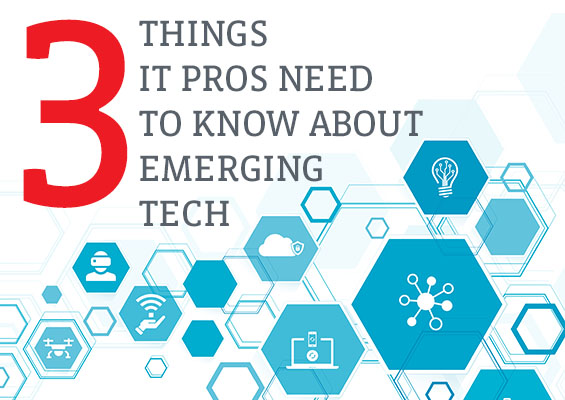
The overarching theme of CompTIA’s latest IT Industry Outlook is that the next big thing is dead. There is no single technology that will redefine IT operations or business strategies. Instead, technologies must be stacked together to produce new and innovative solutions.
Of course, drawing the most interest are emerging technologies. With incredible capability now available at affordable levels and new ideas coming from a wide variety of sources, there are many new trends that organizations are exploring as they try to discover how to drive new growth or reach new customers. With all the exploration, the natural question is around getting the right skills. Rather than seeking out highly specialized skills, the right answer to that question is likely to build new skills on top of existing ones.
3 Things IT Pros Need to Know About Emerging Tech
Three different trends from the Outlook study show how emerging technologies will show up in technology solutions, and CompTIA certifications provide a path to success in all these trends.
1. Emerging Technologies Will Work Alongside Established Technologies to Create New Solutions
Almost every organization now uses cloud computing, and edge computing is an extension of cloud systems that brings compute power closer to the endpoints. But when you add in 5G networks, the result is a new platform for economic activity.
A foundation of cloud/edge/5G allows organizations to build applications that were never possible before, driving a new wave of business opportunity.
CompTIA Network+ gives IT pros the fundamental knowledge needed to build proper networks, even as those networks grow faster and more capable.
2. Emerging Technologies Will Work Together to Change the Concepts of Computing
For example, the internet of things (IoT) and artificial intelligence (AI) will work together to enable ambient computing, where the environment reacts based on context.
Think of smart lighting. It starts as a basic IoT solution, where lighting is connected to a network and can be controlled by an app. The next step is to manually build an automated schedule.
True ambient computing is where the lighting system activates automatically when it senses behavior (like entering or exiting) and learns from that behavior to optimize the schedule or lighting quality.
CompTIA A+ can help IT pros with device management, and CompTIA Linux+ can help with automating processes.
3. Emerging Technologies Will Act as an Enabling Layer For Future Computing Models
Blockchain has been the prime example of digital ledger technology (DLT), which provides an alternative to the centralization behind most existing technology.
DLT removes the need for an individual entity to maintain a record of transactions, distributing that record across a wide network of nodes and potentially improving trust and security. While there are still some hurdles to overcome, DLT could disrupt the entire digital ecosystem if it becomes a new standard for digital activity.
CompTIA Stackable Certifications give IT pros the broad knowledge needed to construct systems, allowing them to adjust if one part of the stack changes.
Emerging technologies hold a great deal of promise, but only if the right skills are in place to leverage them. As technology solutions move further away from individual products and closer to integrated strategies, building skills from the ground up will help IT pros understand new trends and incorporate those trends into existing architecture so that the business can grow.
Read the complete IT Industry Outlook 2019 for more on emerging technology, the IT workforce, strategic IT and more.

